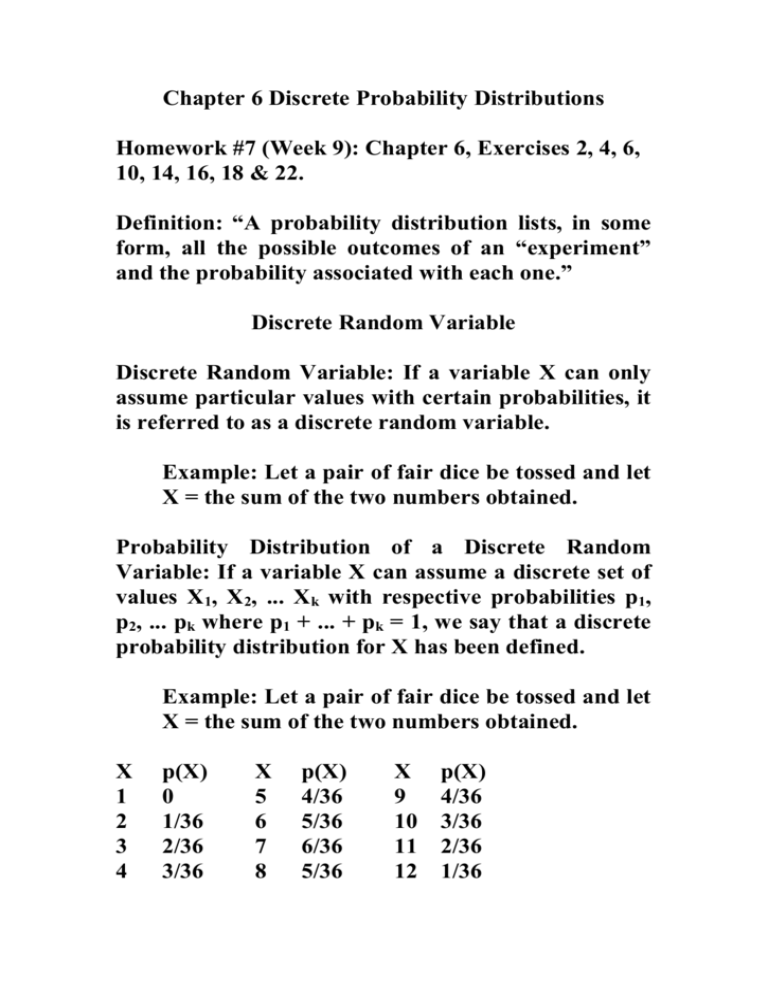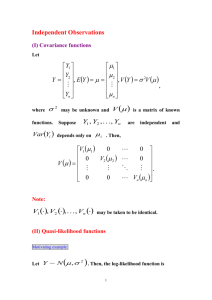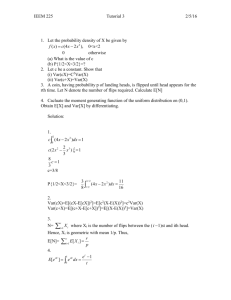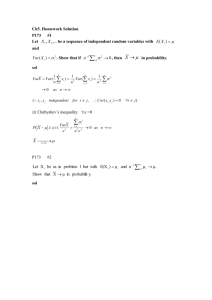Chapter 4 Probability Distributions
advertisement

Chapter 6 Discrete Probability Distributions
Homework #7 (Week 9): Chapter 6, Exercises 2, 4, 6,
10, 14, 16, 18 & 22.
Definition: “A probability distribution lists, in some
form, all the possible outcomes of an “experiment”
and the probability associated with each one.”
Discrete Random Variable
Discrete Random Variable: If a variable X can only
assume particular values with certain probabilities, it
is referred to as a discrete random variable.
Example: Let a pair of fair dice be tossed and let
X = the sum of the two numbers obtained.
Probability Distribution of a Discrete Random
Variable: If a variable X can assume a discrete set of
values X1, X2, ... Xk with respective probabilities p1,
p2, ... pk where p1 + ... + pk = 1, we say that a discrete
probability distribution for X has been defined.
Example: Let a pair of fair dice be tossed and let
X = the sum of the two numbers obtained.
X
1
2
3
4
p(X)
0
1/36
2/36
3/36
X
5
6
7
8
p(X)
4/36
5/36
6/36
5/36
X
9
10
11
12
p(X)
4/36
3/36
2/36
1/36
Population Mean of a Discrete Random Variable
The Population Mean () of the Random Variable X
is also known as the Expected Value (E(X)) of the
Random Variable X.
= E(X) = X1.p1 + X2.p2. + ... + Xk.pk = x.P(x)
Example: Toss of a Fair Die
E(X) = = x.P(x) = 1.(1/6) + 2.(1/6) + 3.(1/6) + 4.(1/6)
+ 5.(1/6) + 6.(1/6)
= 3.5 (interpretation?)
Aside:
E(f(X)) = f(x).P(x)
E(X2) = x2.P(x) = 1.(1/6) + 4.(1/6) + 9.(1/6) + 16.(1/6)
+ 25.(1/6) + 36.(1/6) = (91/6) = 15.17
E(X3) = x3.P(x) = ?
E(X2) 2 in general
[E(X)]2 = 2
Population Variance of a Discrete Random Variable
Var (X) = 2 [Remember 2 = ((xi - )2)/n]
Example: Toss of a Fair Die
(1-3.5)2+(2-3.5)2+(3-3.5)2+(4-3.5)2+(5-3.5)2+(6-3.5)2
6
= 2.92 = 2
Population Standard Deviation = = 1.71
(interpretation?)
Highest Deviation = 2.5 (= 3.5 – 1 = 6 - 3.5)
Lowest Deviation = .5 (= 3.5 – 3 = 4 – 3.5)
Aside:
Population Variance = Var (X) = 2 = E(X - )2
2 = E(X - )2 = (x-)2.P(x)
Short Cut for Calculating Var(X)
E(X-)2 = E(X2-2.X.+2) = E(X2) - E(2.X.) + E(2)
= E(X2) - 2..E(X) + 2
= E(X2) - 2.. + 2
= E(X2) - 2.2 + 2
= E(X2) - 2
Var (X) = E(X2) - 2
Example: Toss of a Fair Die
E(X) = = 3.5
E(X2) = 91/6 = 15.17 (see earlier and/or check)
2 = (3.5)2 = 12.25
Var (X) = E(X2)-2 = 15.17 - 12.25 = 2.92 (as expected)
Linear Combination of a Random Variable
Random Variable: X
E(X) =
Var (X) = 2
Constants: A and B
Define: W = A.X + B (i.e. W is a linear function of X)
E(W)?
E(W) = E(A.X + B) = E(A.X) + E(B) = A.E(X) + B
Var (W)?
Var (W) = E[W – E(W)]2 = E[A.X + B - E(A.X + B)]2
= E[A.X + B - E(A.X) - E(B)]2
= E[A.X + B - A.E(X) - B]2
= E[A.X - A.E(X)]2
= A2.E[X - E(X)]2
= A2.Var (X)
{Stan Dev (W) = (Var (W))½ = A.Stan Dev (X)}
Example: Let W = (X - )/ where E(X) = and Var
(X) = 2
i.e. X ~ (,2) [ “~” means “is distributed”]
W = (X - )/ = X/ - /
i.e. W = A.X + B where
A = 1/ and B = - /
E(W) = A.E(X) + B = (1/).() - / = 0
Var (W) = A2.Var (X) = (1/)2.2 = 1
W ~ (0, 1)
Note: W is called the standardised random variable
The Binomial Distribution
n: number of trials
x: number of “successes” within n trials
: probability of “success” in any individual trial
(1-): probability of “failure” in any individual trial
P(x) = nCx x (1-)n-x
Claims:
1. E(x) = n (intuitive)
2. Var(x) = n(1-) (not so intuitive)
“Proof”
Let xi = number of “successes” within any individual
trial
xi = 1 with probability
xi = 0 with probability (1-)
E(xi) = .1 + (1-).0 = (as expected)
Aside: E(xi2) = .12 + (1-).02 =
Var(xi) = E[xi - E(xi)]2 = E[xi - ]2 = E[xi2 - 2xi + 2]
= E[xi2] – E[2xi] + E[2] = E[xi2] – 2E[xi] + 2
= E[xi2] – 2 + 2
= E[xi2] – 2
= – 2
= (1 - )
x = number of “successes” within n (statistically
independent) trials
x = x 1 + x2 + … + x i + … + x n
1. E(x) = E(x1) + E(x2) + … + E(xi) + … + E(xn) = n
2. Var(x) = Var(x1) + Var(x2) + … + Var(xi) + … +
Var(xn) = n(1 - )









